Information Sharing for Patient Care
VerifiedAdded on 2020/06/06
|12
|3210
|62
AI Summary
This assignment examines the crucial role of information sharing among those involved in providing patient care. It delves into the 'how' and 'why' behind effective communication, highlighting its impact on treatment plans, coordination of services, and ultimately, patient well-being.
Contribute Materials
Your contribution can guide someone’s learning journey. Share your
documents today.
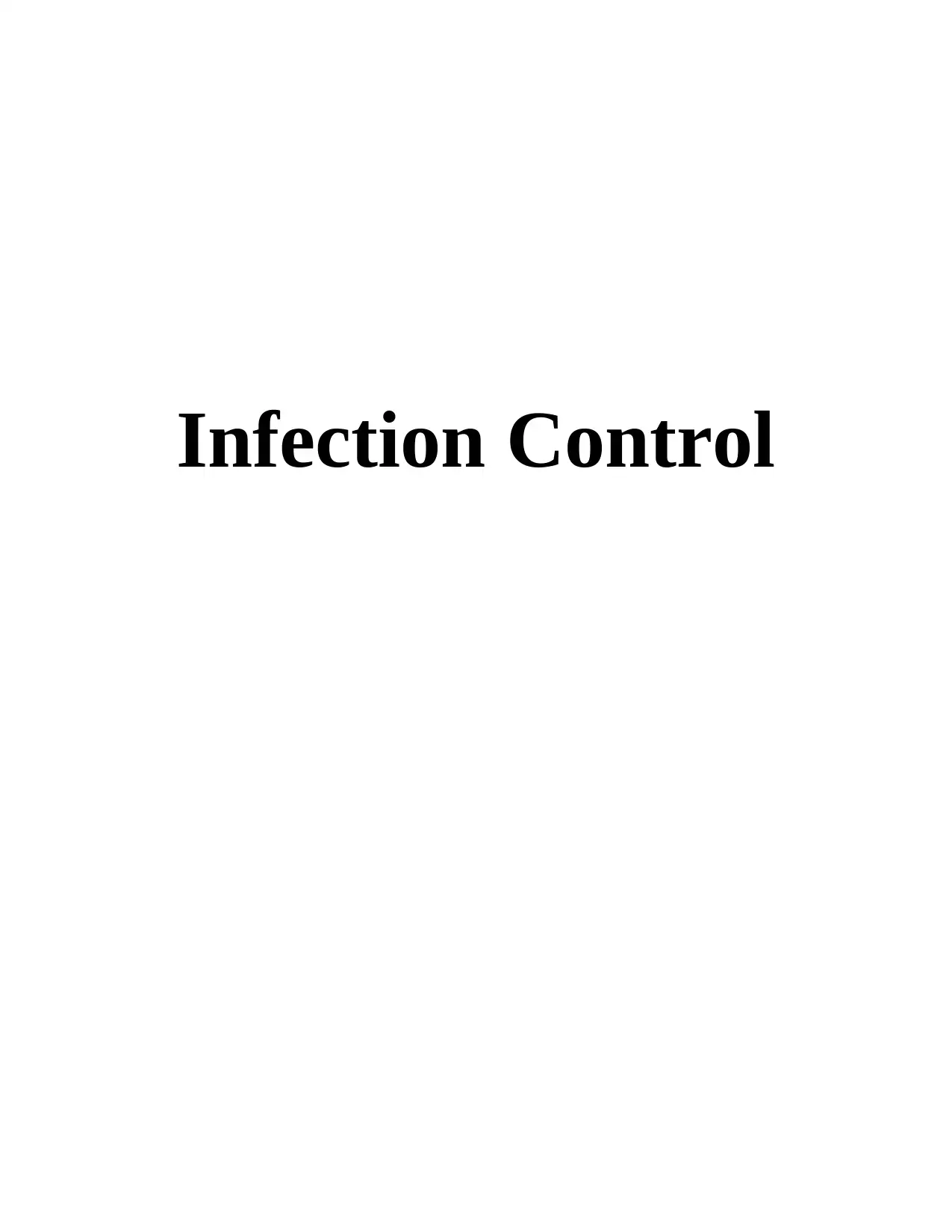
Infection Control
Secure Best Marks with AI Grader
Need help grading? Try our AI Grader for instant feedback on your assignments.
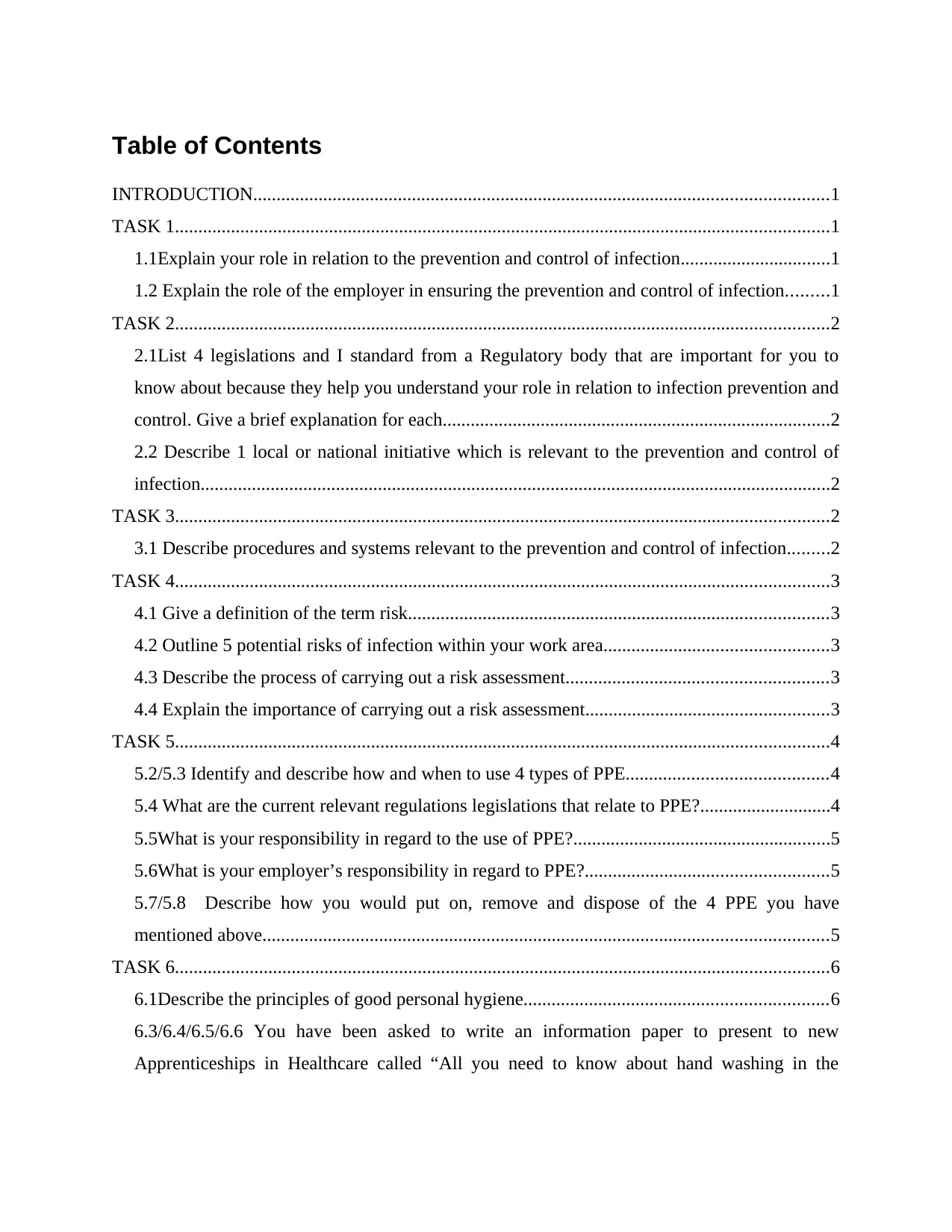
Table of Contents
INTRODUCTION...........................................................................................................................1
TASK 1............................................................................................................................................1
1.1Explain your role in relation to the prevention and control of infection................................1
1.2 Explain the role of the employer in ensuring the prevention and control of infection.........1
TASK 2............................................................................................................................................2
2.1List 4 legislations and I standard from a Regulatory body that are important for you to
know about because they help you understand your role in relation to infection prevention and
control. Give a brief explanation for each...................................................................................2
2.2 Describe 1 local or national initiative which is relevant to the prevention and control of
infection.......................................................................................................................................2
TASK 3............................................................................................................................................2
3.1 Describe procedures and systems relevant to the prevention and control of infection.........2
TASK 4............................................................................................................................................3
4.1 Give a definition of the term risk..........................................................................................3
4.2 Outline 5 potential risks of infection within your work area................................................3
4.3 Describe the process of carrying out a risk assessment........................................................3
4.4 Explain the importance of carrying out a risk assessment....................................................3
TASK 5............................................................................................................................................4
5.2/5.3 Identify and describe how and when to use 4 types of PPE...........................................4
5.4 What are the current relevant regulations legislations that relate to PPE?............................4
5.5What is your responsibility in regard to the use of PPE?.......................................................5
5.6What is your employer’s responsibility in regard to PPE?....................................................5
5.7/5.8 Describe how you would put on, remove and dispose of the 4 PPE you have
mentioned above.........................................................................................................................5
TASK 6............................................................................................................................................6
6.1Describe the principles of good personal hygiene.................................................................6
6.3/6.4/6.5/6.6 You have been asked to write an information paper to present to new
Apprenticeships in Healthcare called “All you need to know about hand washing in the
INTRODUCTION...........................................................................................................................1
TASK 1............................................................................................................................................1
1.1Explain your role in relation to the prevention and control of infection................................1
1.2 Explain the role of the employer in ensuring the prevention and control of infection.........1
TASK 2............................................................................................................................................2
2.1List 4 legislations and I standard from a Regulatory body that are important for you to
know about because they help you understand your role in relation to infection prevention and
control. Give a brief explanation for each...................................................................................2
2.2 Describe 1 local or national initiative which is relevant to the prevention and control of
infection.......................................................................................................................................2
TASK 3............................................................................................................................................2
3.1 Describe procedures and systems relevant to the prevention and control of infection.........2
TASK 4............................................................................................................................................3
4.1 Give a definition of the term risk..........................................................................................3
4.2 Outline 5 potential risks of infection within your work area................................................3
4.3 Describe the process of carrying out a risk assessment........................................................3
4.4 Explain the importance of carrying out a risk assessment....................................................3
TASK 5............................................................................................................................................4
5.2/5.3 Identify and describe how and when to use 4 types of PPE...........................................4
5.4 What are the current relevant regulations legislations that relate to PPE?............................4
5.5What is your responsibility in regard to the use of PPE?.......................................................5
5.6What is your employer’s responsibility in regard to PPE?....................................................5
5.7/5.8 Describe how you would put on, remove and dispose of the 4 PPE you have
mentioned above.........................................................................................................................5
TASK 6............................................................................................................................................6
6.1Describe the principles of good personal hygiene.................................................................6
6.3/6.4/6.5/6.6 You have been asked to write an information paper to present to new
Apprenticeships in Healthcare called “All you need to know about hand washing in the
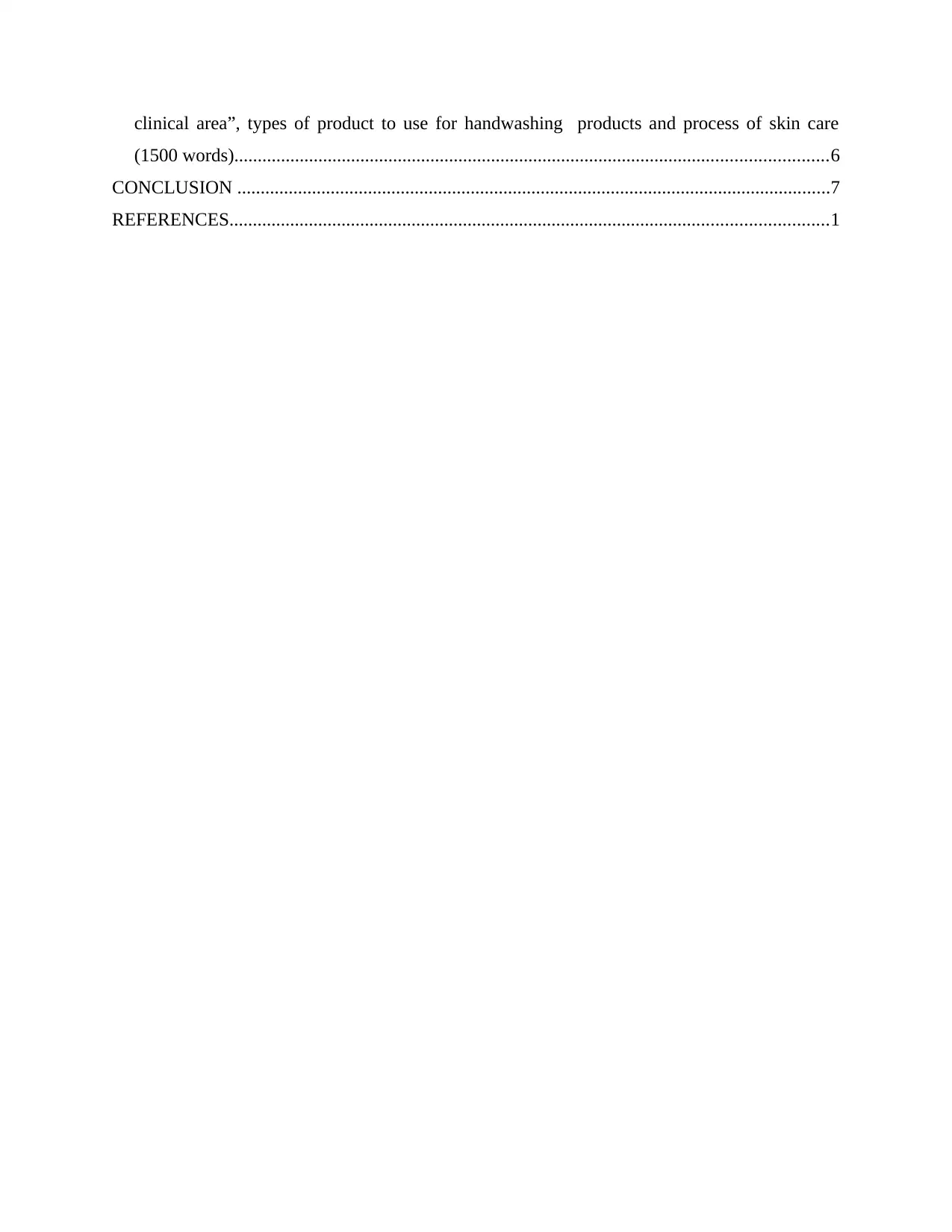
clinical area”, types of product to use for handwashing products and process of skin care
(1500 words)...............................................................................................................................6
CONCLUSION ...............................................................................................................................7
REFERENCES................................................................................................................................1
(1500 words)...............................................................................................................................6
CONCLUSION ...............................................................................................................................7
REFERENCES................................................................................................................................1
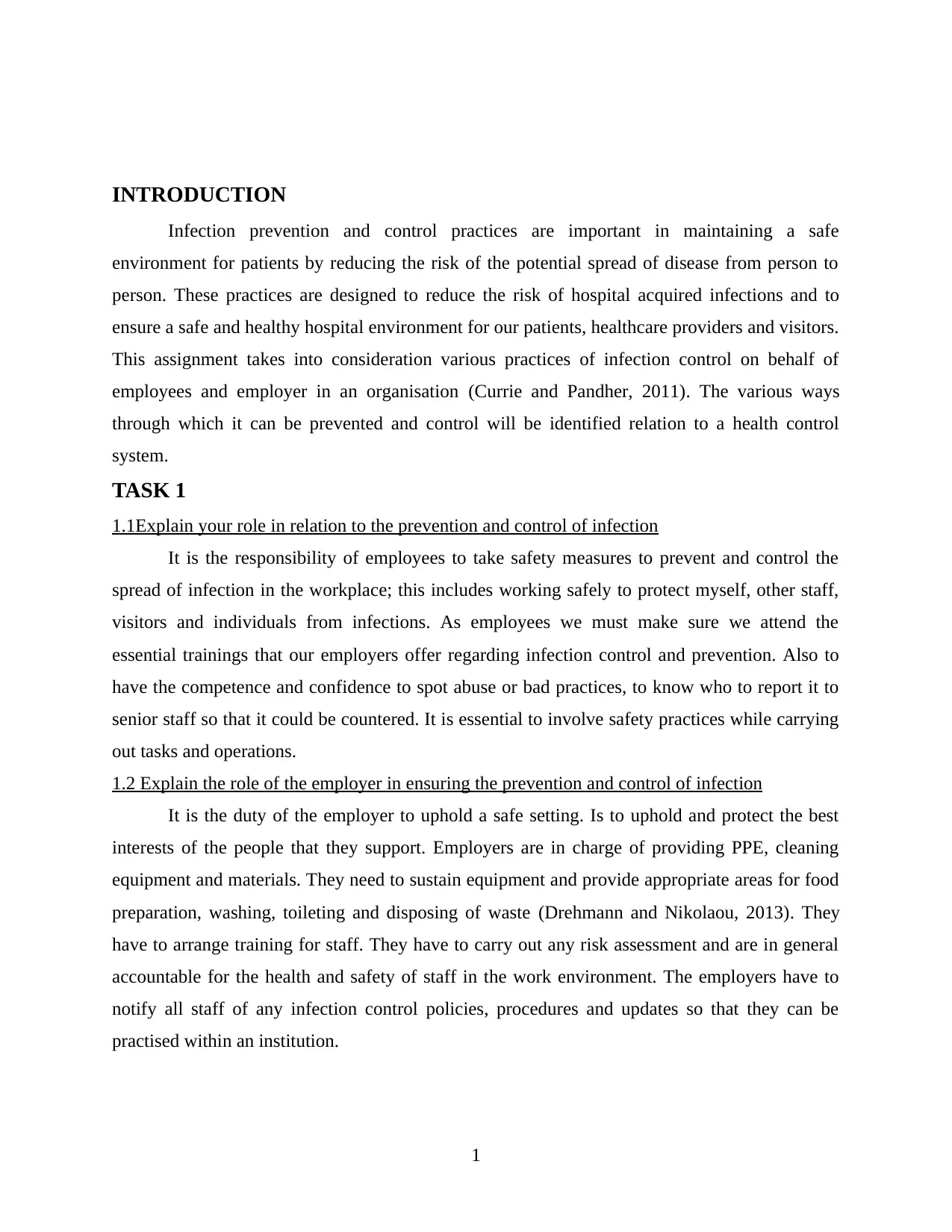
INTRODUCTION
Infection prevention and control practices are important in maintaining a safe
environment for patients by reducing the risk of the potential spread of disease from person to
person. These practices are designed to reduce the risk of hospital acquired infections and to
ensure a safe and healthy hospital environment for our patients, healthcare providers and visitors.
This assignment takes into consideration various practices of infection control on behalf of
employees and employer in an organisation (Currie and Pandher, 2011). The various ways
through which it can be prevented and control will be identified relation to a health control
system.
TASK 1
1.1Explain your role in relation to the prevention and control of infection
It is the responsibility of employees to take safety measures to prevent and control the
spread of infection in the workplace; this includes working safely to protect myself, other staff,
visitors and individuals from infections. As employees we must make sure we attend the
essential trainings that our employers offer regarding infection control and prevention. Also to
have the competence and confidence to spot abuse or bad practices, to know who to report it to
senior staff so that it could be countered. It is essential to involve safety practices while carrying
out tasks and operations.
1.2 Explain the role of the employer in ensuring the prevention and control of infection
It is the duty of the employer to uphold a safe setting. Is to uphold and protect the best
interests of the people that they support. Employers are in charge of providing PPE, cleaning
equipment and materials. They need to sustain equipment and provide appropriate areas for food
preparation, washing, toileting and disposing of waste (Drehmann and Nikolaou, 2013). They
have to arrange training for staff. They have to carry out any risk assessment and are in general
accountable for the health and safety of staff in the work environment. The employers have to
notify all staff of any infection control policies, procedures and updates so that they can be
practised within an institution.
1
Infection prevention and control practices are important in maintaining a safe
environment for patients by reducing the risk of the potential spread of disease from person to
person. These practices are designed to reduce the risk of hospital acquired infections and to
ensure a safe and healthy hospital environment for our patients, healthcare providers and visitors.
This assignment takes into consideration various practices of infection control on behalf of
employees and employer in an organisation (Currie and Pandher, 2011). The various ways
through which it can be prevented and control will be identified relation to a health control
system.
TASK 1
1.1Explain your role in relation to the prevention and control of infection
It is the responsibility of employees to take safety measures to prevent and control the
spread of infection in the workplace; this includes working safely to protect myself, other staff,
visitors and individuals from infections. As employees we must make sure we attend the
essential trainings that our employers offer regarding infection control and prevention. Also to
have the competence and confidence to spot abuse or bad practices, to know who to report it to
senior staff so that it could be countered. It is essential to involve safety practices while carrying
out tasks and operations.
1.2 Explain the role of the employer in ensuring the prevention and control of infection
It is the duty of the employer to uphold a safe setting. Is to uphold and protect the best
interests of the people that they support. Employers are in charge of providing PPE, cleaning
equipment and materials. They need to sustain equipment and provide appropriate areas for food
preparation, washing, toileting and disposing of waste (Drehmann and Nikolaou, 2013). They
have to arrange training for staff. They have to carry out any risk assessment and are in general
accountable for the health and safety of staff in the work environment. The employers have to
notify all staff of any infection control policies, procedures and updates so that they can be
practised within an institution.
1
Secure Best Marks with AI Grader
Need help grading? Try our AI Grader for instant feedback on your assignments.
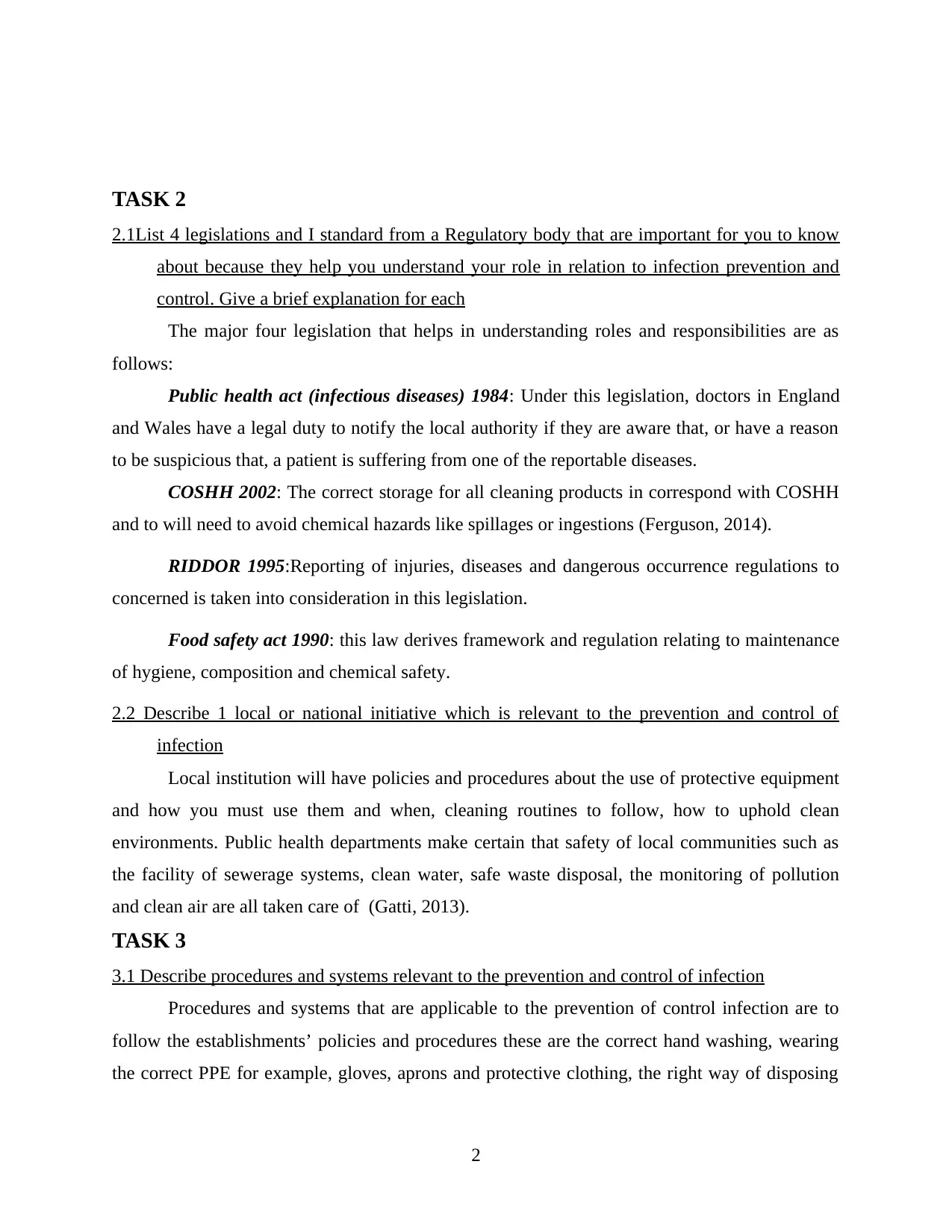
TASK 2
2.1List 4 legislations and I standard from a Regulatory body that are important for you to know
about because they help you understand your role in relation to infection prevention and
control. Give a brief explanation for each
The major four legislation that helps in understanding roles and responsibilities are as
follows:
Public health act (infectious diseases) 1984: Under this legislation, doctors in England
and Wales have a legal duty to notify the local authority if they are aware that, or have a reason
to be suspicious that, a patient is suffering from one of the reportable diseases.
COSHH 2002: The correct storage for all cleaning products in correspond with COSHH
and to will need to avoid chemical hazards like spillages or ingestions (Ferguson, 2014).
RIDDOR 1995:Reporting of injuries, diseases and dangerous occurrence regulations to
concerned is taken into consideration in this legislation.
Food safety act 1990: this law derives framework and regulation relating to maintenance
of hygiene, composition and chemical safety.
2.2 Describe 1 local or national initiative which is relevant to the prevention and control of
infection
Local institution will have policies and procedures about the use of protective equipment
and how you must use them and when, cleaning routines to follow, how to uphold clean
environments. Public health departments make certain that safety of local communities such as
the facility of sewerage systems, clean water, safe waste disposal, the monitoring of pollution
and clean air are all taken care of (Gatti, 2013).
TASK 3
3.1 Describe procedures and systems relevant to the prevention and control of infection
Procedures and systems that are applicable to the prevention of control infection are to
follow the establishments’ policies and procedures these are the correct hand washing, wearing
the correct PPE for example, gloves, aprons and protective clothing, the right way of disposing
2
2.1List 4 legislations and I standard from a Regulatory body that are important for you to know
about because they help you understand your role in relation to infection prevention and
control. Give a brief explanation for each
The major four legislation that helps in understanding roles and responsibilities are as
follows:
Public health act (infectious diseases) 1984: Under this legislation, doctors in England
and Wales have a legal duty to notify the local authority if they are aware that, or have a reason
to be suspicious that, a patient is suffering from one of the reportable diseases.
COSHH 2002: The correct storage for all cleaning products in correspond with COSHH
and to will need to avoid chemical hazards like spillages or ingestions (Ferguson, 2014).
RIDDOR 1995:Reporting of injuries, diseases and dangerous occurrence regulations to
concerned is taken into consideration in this legislation.
Food safety act 1990: this law derives framework and regulation relating to maintenance
of hygiene, composition and chemical safety.
2.2 Describe 1 local or national initiative which is relevant to the prevention and control of
infection
Local institution will have policies and procedures about the use of protective equipment
and how you must use them and when, cleaning routines to follow, how to uphold clean
environments. Public health departments make certain that safety of local communities such as
the facility of sewerage systems, clean water, safe waste disposal, the monitoring of pollution
and clean air are all taken care of (Gatti, 2013).
TASK 3
3.1 Describe procedures and systems relevant to the prevention and control of infection
Procedures and systems that are applicable to the prevention of control infection are to
follow the establishments’ policies and procedures these are the correct hand washing, wearing
the correct PPE for example, gloves, aprons and protective clothing, the right way of disposing
2
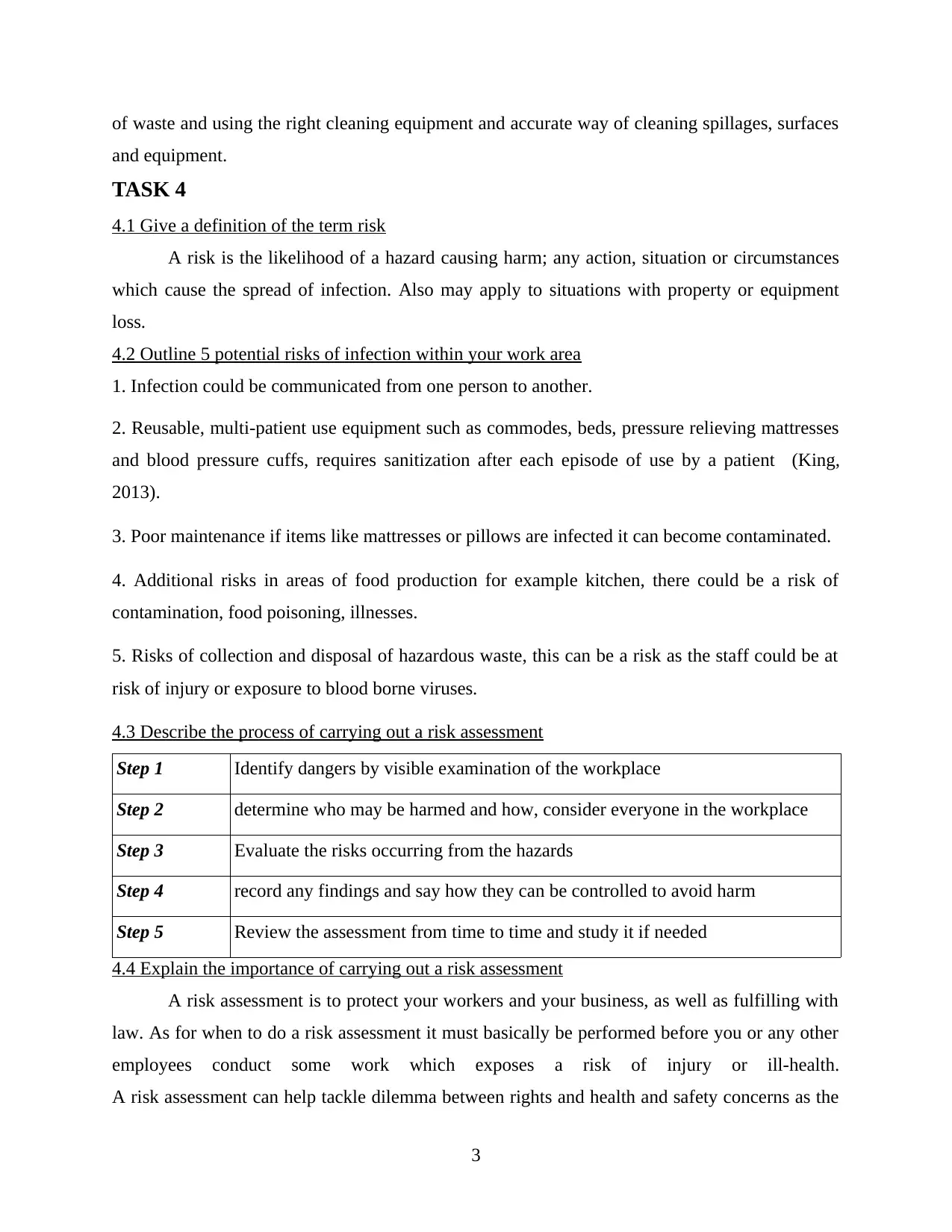
of waste and using the right cleaning equipment and accurate way of cleaning spillages, surfaces
and equipment.
TASK 4
4.1 Give a definition of the term risk
A risk is the likelihood of a hazard causing harm; any action, situation or circumstances
which cause the spread of infection. Also may apply to situations with property or equipment
loss.
4.2 Outline 5 potential risks of infection within your work area
1. Infection could be communicated from one person to another.
2. Reusable, multi-patient use equipment such as commodes, beds, pressure relieving mattresses
and blood pressure cuffs, requires sanitization after each episode of use by a patient (King,
2013).
3. Poor maintenance if items like mattresses or pillows are infected it can become contaminated.
4. Additional risks in areas of food production for example kitchen, there could be a risk of
contamination, food poisoning, illnesses.
5. Risks of collection and disposal of hazardous waste, this can be a risk as the staff could be at
risk of injury or exposure to blood borne viruses.
4.3 Describe the process of carrying out a risk assessment
Step 1 Identify dangers by visible examination of the workplace
Step 2 determine who may be harmed and how, consider everyone in the workplace
Step 3 Evaluate the risks occurring from the hazards
Step 4 record any findings and say how they can be controlled to avoid harm
Step 5 Review the assessment from time to time and study it if needed
4.4 Explain the importance of carrying out a risk assessment
A risk assessment is to protect your workers and your business, as well as fulfilling with
law. As for when to do a risk assessment it must basically be performed before you or any other
employees conduct some work which exposes a risk of injury or ill-health.
A risk assessment can help tackle dilemma between rights and health and safety concerns as the
3
and equipment.
TASK 4
4.1 Give a definition of the term risk
A risk is the likelihood of a hazard causing harm; any action, situation or circumstances
which cause the spread of infection. Also may apply to situations with property or equipment
loss.
4.2 Outline 5 potential risks of infection within your work area
1. Infection could be communicated from one person to another.
2. Reusable, multi-patient use equipment such as commodes, beds, pressure relieving mattresses
and blood pressure cuffs, requires sanitization after each episode of use by a patient (King,
2013).
3. Poor maintenance if items like mattresses or pillows are infected it can become contaminated.
4. Additional risks in areas of food production for example kitchen, there could be a risk of
contamination, food poisoning, illnesses.
5. Risks of collection and disposal of hazardous waste, this can be a risk as the staff could be at
risk of injury or exposure to blood borne viruses.
4.3 Describe the process of carrying out a risk assessment
Step 1 Identify dangers by visible examination of the workplace
Step 2 determine who may be harmed and how, consider everyone in the workplace
Step 3 Evaluate the risks occurring from the hazards
Step 4 record any findings and say how they can be controlled to avoid harm
Step 5 Review the assessment from time to time and study it if needed
4.4 Explain the importance of carrying out a risk assessment
A risk assessment is to protect your workers and your business, as well as fulfilling with
law. As for when to do a risk assessment it must basically be performed before you or any other
employees conduct some work which exposes a risk of injury or ill-health.
A risk assessment can help tackle dilemma between rights and health and safety concerns as the
3
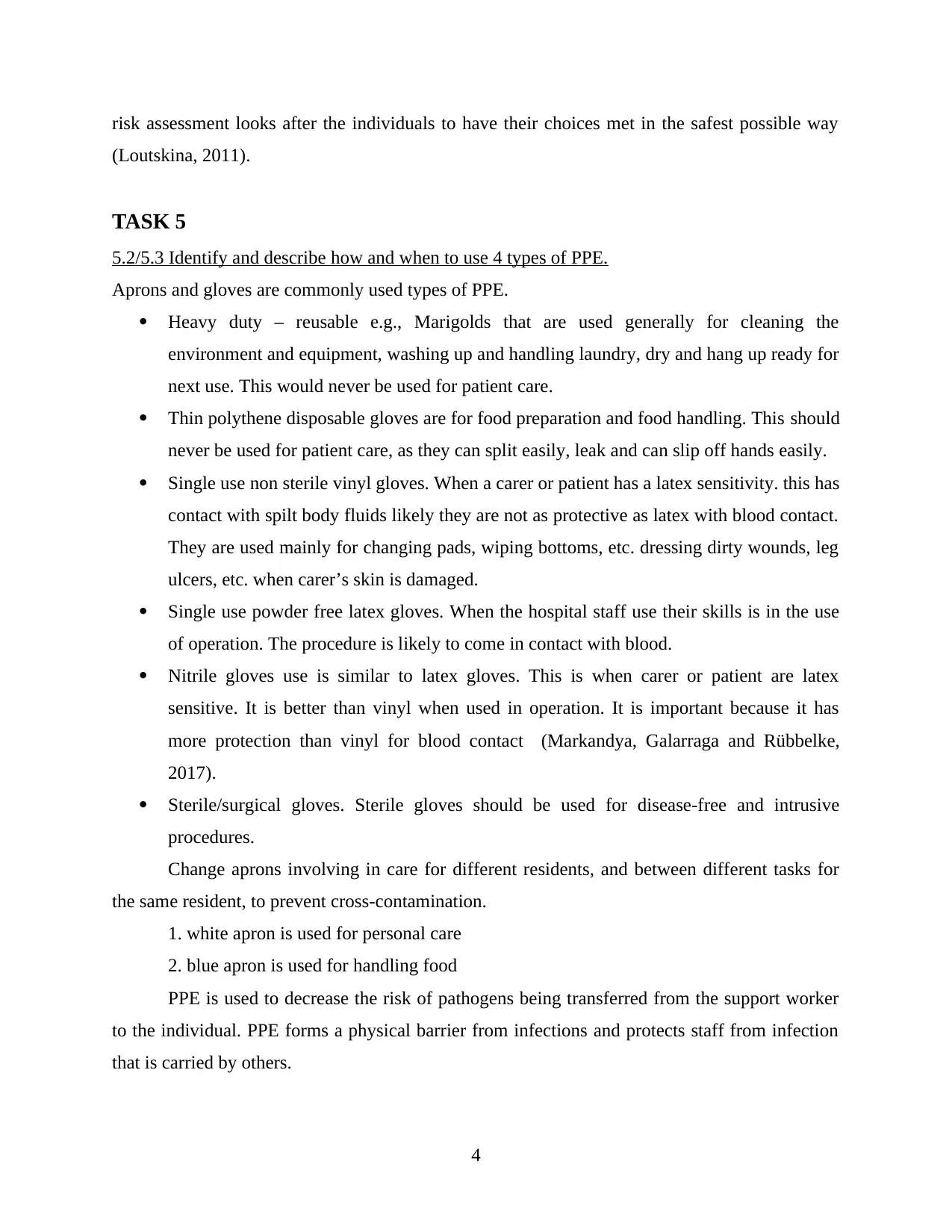
risk assessment looks after the individuals to have their choices met in the safest possible way
(Loutskina, 2011).
TASK 5
5.2/5.3 Identify and describe how and when to use 4 types of PPE.
Aprons and gloves are commonly used types of PPE.
Heavy duty – reusable e.g., Marigolds that are used generally for cleaning the
environment and equipment, washing up and handling laundry, dry and hang up ready for
next use. This would never be used for patient care.
Thin polythene disposable gloves are for food preparation and food handling. This should
never be used for patient care, as they can split easily, leak and can slip off hands easily.
Single use non sterile vinyl gloves. When a carer or patient has a latex sensitivity. this has
contact with spilt body fluids likely they are not as protective as latex with blood contact.
They are used mainly for changing pads, wiping bottoms, etc. dressing dirty wounds, leg
ulcers, etc. when carer’s skin is damaged.
Single use powder free latex gloves. When the hospital staff use their skills is in the use
of operation. The procedure is likely to come in contact with blood.
Nitrile gloves use is similar to latex gloves. This is when carer or patient are latex
sensitive. It is better than vinyl when used in operation. It is important because it has
more protection than vinyl for blood contact (Markandya, Galarraga and Rübbelke,
2017).
Sterile/surgical gloves. Sterile gloves should be used for disease-free and intrusive
procedures.
Change aprons involving in care for different residents, and between different tasks for
the same resident, to prevent cross-contamination.
1. white apron is used for personal care
2. blue apron is used for handling food
PPE is used to decrease the risk of pathogens being transferred from the support worker
to the individual. PPE forms a physical barrier from infections and protects staff from infection
that is carried by others.
4
(Loutskina, 2011).
TASK 5
5.2/5.3 Identify and describe how and when to use 4 types of PPE.
Aprons and gloves are commonly used types of PPE.
Heavy duty – reusable e.g., Marigolds that are used generally for cleaning the
environment and equipment, washing up and handling laundry, dry and hang up ready for
next use. This would never be used for patient care.
Thin polythene disposable gloves are for food preparation and food handling. This should
never be used for patient care, as they can split easily, leak and can slip off hands easily.
Single use non sterile vinyl gloves. When a carer or patient has a latex sensitivity. this has
contact with spilt body fluids likely they are not as protective as latex with blood contact.
They are used mainly for changing pads, wiping bottoms, etc. dressing dirty wounds, leg
ulcers, etc. when carer’s skin is damaged.
Single use powder free latex gloves. When the hospital staff use their skills is in the use
of operation. The procedure is likely to come in contact with blood.
Nitrile gloves use is similar to latex gloves. This is when carer or patient are latex
sensitive. It is better than vinyl when used in operation. It is important because it has
more protection than vinyl for blood contact (Markandya, Galarraga and Rübbelke,
2017).
Sterile/surgical gloves. Sterile gloves should be used for disease-free and intrusive
procedures.
Change aprons involving in care for different residents, and between different tasks for
the same resident, to prevent cross-contamination.
1. white apron is used for personal care
2. blue apron is used for handling food
PPE is used to decrease the risk of pathogens being transferred from the support worker
to the individual. PPE forms a physical barrier from infections and protects staff from infection
that is carried by others.
4
Paraphrase This Document
Need a fresh take? Get an instant paraphrase of this document with our AI Paraphraser
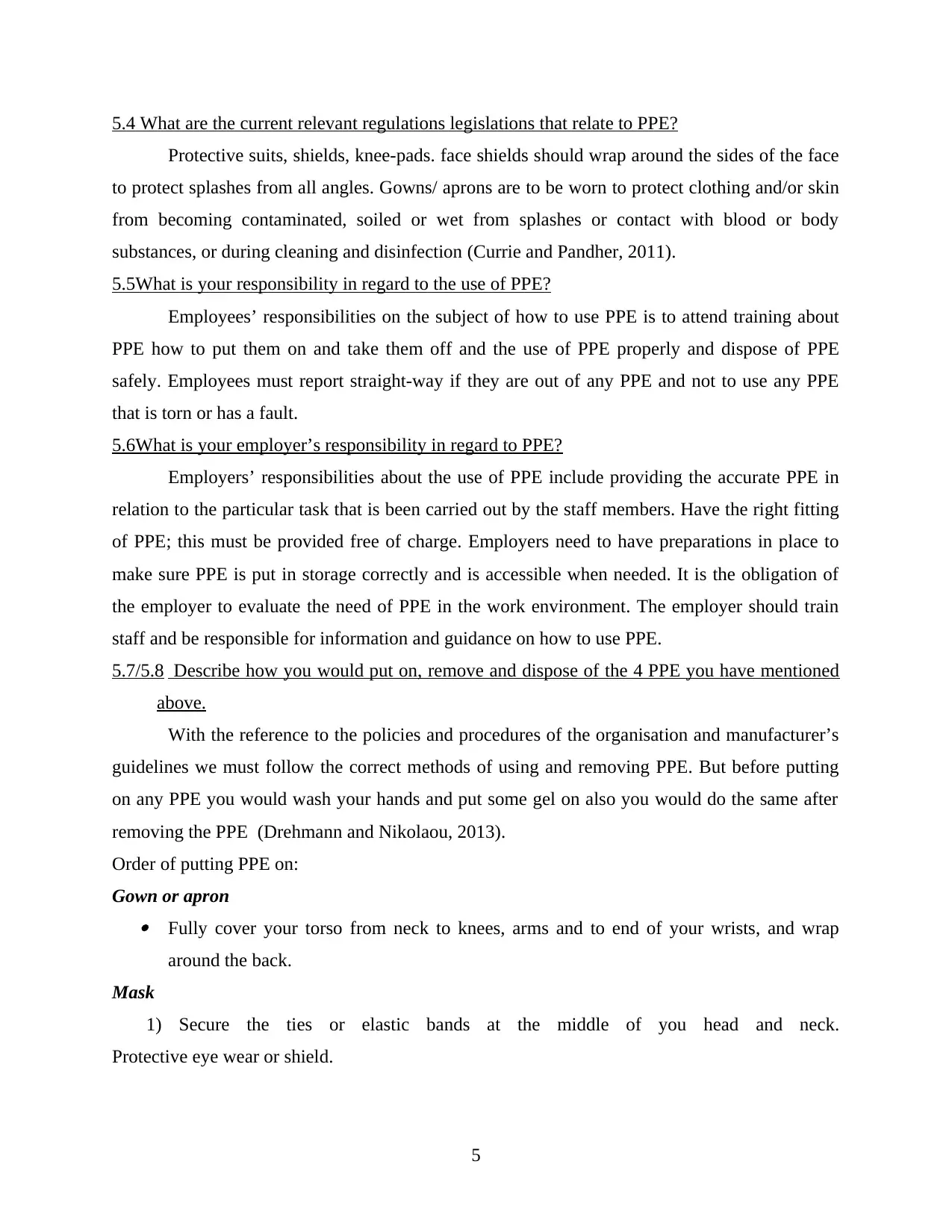
5.4 What are the current relevant regulations legislations that relate to PPE?
Protective suits, shields, knee-pads. face shields should wrap around the sides of the face
to protect splashes from all angles. Gowns/ aprons are to be worn to protect clothing and/or skin
from becoming contaminated, soiled or wet from splashes or contact with blood or body
substances, or during cleaning and disinfection (Currie and Pandher, 2011).
5.5What is your responsibility in regard to the use of PPE?
Employees’ responsibilities on the subject of how to use PPE is to attend training about
PPE how to put them on and take them off and the use of PPE properly and dispose of PPE
safely. Employees must report straight-way if they are out of any PPE and not to use any PPE
that is torn or has a fault.
5.6What is your employer’s responsibility in regard to PPE?
Employers’ responsibilities about the use of PPE include providing the accurate PPE in
relation to the particular task that is been carried out by the staff members. Have the right fitting
of PPE; this must be provided free of charge. Employers need to have preparations in place to
make sure PPE is put in storage correctly and is accessible when needed. It is the obligation of
the employer to evaluate the need of PPE in the work environment. The employer should train
staff and be responsible for information and guidance on how to use PPE.
5.7/5.8 Describe how you would put on, remove and dispose of the 4 PPE you have mentioned
above.
With the reference to the policies and procedures of the organisation and manufacturer’s
guidelines we must follow the correct methods of using and removing PPE. But before putting
on any PPE you would wash your hands and put some gel on also you would do the same after
removing the PPE (Drehmann and Nikolaou, 2013).
Order of putting PPE on:
Gown or apron Fully cover your torso from neck to knees, arms and to end of your wrists, and wrap
around the back.
Mask
1) Secure the ties or elastic bands at the middle of you head and neck.
Protective eye wear or shield.
5
Protective suits, shields, knee-pads. face shields should wrap around the sides of the face
to protect splashes from all angles. Gowns/ aprons are to be worn to protect clothing and/or skin
from becoming contaminated, soiled or wet from splashes or contact with blood or body
substances, or during cleaning and disinfection (Currie and Pandher, 2011).
5.5What is your responsibility in regard to the use of PPE?
Employees’ responsibilities on the subject of how to use PPE is to attend training about
PPE how to put them on and take them off and the use of PPE properly and dispose of PPE
safely. Employees must report straight-way if they are out of any PPE and not to use any PPE
that is torn or has a fault.
5.6What is your employer’s responsibility in regard to PPE?
Employers’ responsibilities about the use of PPE include providing the accurate PPE in
relation to the particular task that is been carried out by the staff members. Have the right fitting
of PPE; this must be provided free of charge. Employers need to have preparations in place to
make sure PPE is put in storage correctly and is accessible when needed. It is the obligation of
the employer to evaluate the need of PPE in the work environment. The employer should train
staff and be responsible for information and guidance on how to use PPE.
5.7/5.8 Describe how you would put on, remove and dispose of the 4 PPE you have mentioned
above.
With the reference to the policies and procedures of the organisation and manufacturer’s
guidelines we must follow the correct methods of using and removing PPE. But before putting
on any PPE you would wash your hands and put some gel on also you would do the same after
removing the PPE (Drehmann and Nikolaou, 2013).
Order of putting PPE on:
Gown or apron Fully cover your torso from neck to knees, arms and to end of your wrists, and wrap
around the back.
Mask
1) Secure the ties or elastic bands at the middle of you head and neck.
Protective eye wear or shield.
5

Gloves
•Outside of gloves will be contaminated!
• Grip the outside of the glove with your opposite gloved hand; and peel off the glove.
It is essential to know about waste streams in any place of work and follow them. it’s our
obligation to separate items and dispose of them in the accurate waste stream. It’s necessary that
you get to know this colour-coding system and identify the right containers for the right waste
(Ferguson, 2014).
Orange: is an infectious waste that is sent for treatment to make it safe prior to disposal.
Waste that is contaminated with bodily fluids may pose a possible infection risk. There are
Orange bag, orange-lidded boxes and rigid yellow sharps receptacles.
Examples
•Dressings. •Bandages. •Protective clothing (for example, gloves or aprons).
TASK 6
6.1Describe the principles of good personal hygiene.
1. Wash your hands before and after tasks.
2. Bath frequently to stop the spread of infection and body odour.
3. Keep your hair clean and tied back.
4. Wear clean clothing and make certain your uniforms worn and washed often and only wear in
the workplace to avoid the spread of infection.
5. Keep your nails trimmed and clean.
6. Not to wear jewellery at work as this can be a way of transferring pathogens.
6.3/6.4/6.5/6.6 You have been asked to write an information paper to present to new
Apprenticeships in Healthcare called “All you need to know about hand washing in the
clinical area”, types of product to use for handwashing products and process of skin care
(1500 words).
1. You must wash hands carefully using warm water and liquid soap.
2. Work up to a leather and make sure you wash your wrists, hands, fingers, thumbs, fingernails
and between the fingers.
6
•Outside of gloves will be contaminated!
• Grip the outside of the glove with your opposite gloved hand; and peel off the glove.
It is essential to know about waste streams in any place of work and follow them. it’s our
obligation to separate items and dispose of them in the accurate waste stream. It’s necessary that
you get to know this colour-coding system and identify the right containers for the right waste
(Ferguson, 2014).
Orange: is an infectious waste that is sent for treatment to make it safe prior to disposal.
Waste that is contaminated with bodily fluids may pose a possible infection risk. There are
Orange bag, orange-lidded boxes and rigid yellow sharps receptacles.
Examples
•Dressings. •Bandages. •Protective clothing (for example, gloves or aprons).
TASK 6
6.1Describe the principles of good personal hygiene.
1. Wash your hands before and after tasks.
2. Bath frequently to stop the spread of infection and body odour.
3. Keep your hair clean and tied back.
4. Wear clean clothing and make certain your uniforms worn and washed often and only wear in
the workplace to avoid the spread of infection.
5. Keep your nails trimmed and clean.
6. Not to wear jewellery at work as this can be a way of transferring pathogens.
6.3/6.4/6.5/6.6 You have been asked to write an information paper to present to new
Apprenticeships in Healthcare called “All you need to know about hand washing in the
clinical area”, types of product to use for handwashing products and process of skin care
(1500 words).
1. You must wash hands carefully using warm water and liquid soap.
2. Work up to a leather and make sure you wash your wrists, hands, fingers, thumbs, fingernails
and between the fingers.
6
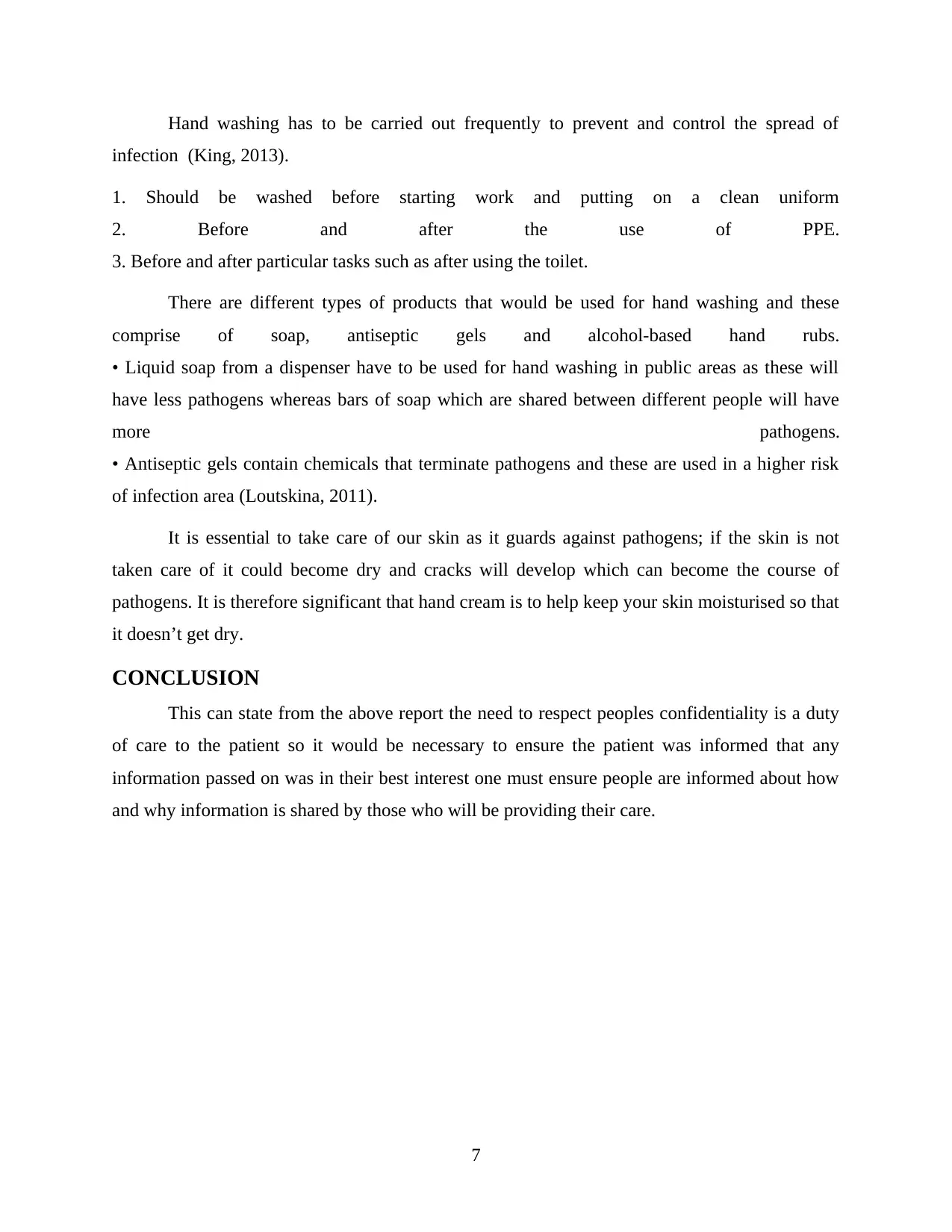
Hand washing has to be carried out frequently to prevent and control the spread of
infection (King, 2013).
1. Should be washed before starting work and putting on a clean uniform
2. Before and after the use of PPE.
3. Before and after particular tasks such as after using the toilet.
There are different types of products that would be used for hand washing and these
comprise of soap, antiseptic gels and alcohol-based hand rubs.
• Liquid soap from a dispenser have to be used for hand washing in public areas as these will
have less pathogens whereas bars of soap which are shared between different people will have
more pathogens.
• Antiseptic gels contain chemicals that terminate pathogens and these are used in a higher risk
of infection area (Loutskina, 2011).
It is essential to take care of our skin as it guards against pathogens; if the skin is not
taken care of it could become dry and cracks will develop which can become the course of
pathogens. It is therefore significant that hand cream is to help keep your skin moisturised so that
it doesn’t get dry.
CONCLUSION
This can state from the above report the need to respect peoples confidentiality is a duty
of care to the patient so it would be necessary to ensure the patient was informed that any
information passed on was in their best interest one must ensure people are informed about how
and why information is shared by those who will be providing their care.
7
infection (King, 2013).
1. Should be washed before starting work and putting on a clean uniform
2. Before and after the use of PPE.
3. Before and after particular tasks such as after using the toilet.
There are different types of products that would be used for hand washing and these
comprise of soap, antiseptic gels and alcohol-based hand rubs.
• Liquid soap from a dispenser have to be used for hand washing in public areas as these will
have less pathogens whereas bars of soap which are shared between different people will have
more pathogens.
• Antiseptic gels contain chemicals that terminate pathogens and these are used in a higher risk
of infection area (Loutskina, 2011).
It is essential to take care of our skin as it guards against pathogens; if the skin is not
taken care of it could become dry and cracks will develop which can become the course of
pathogens. It is therefore significant that hand cream is to help keep your skin moisturised so that
it doesn’t get dry.
CONCLUSION
This can state from the above report the need to respect peoples confidentiality is a duty
of care to the patient so it would be necessary to ensure the patient was informed that any
information passed on was in their best interest one must ensure people are informed about how
and why information is shared by those who will be providing their care.
7
Secure Best Marks with AI Grader
Need help grading? Try our AI Grader for instant feedback on your assignments.

8
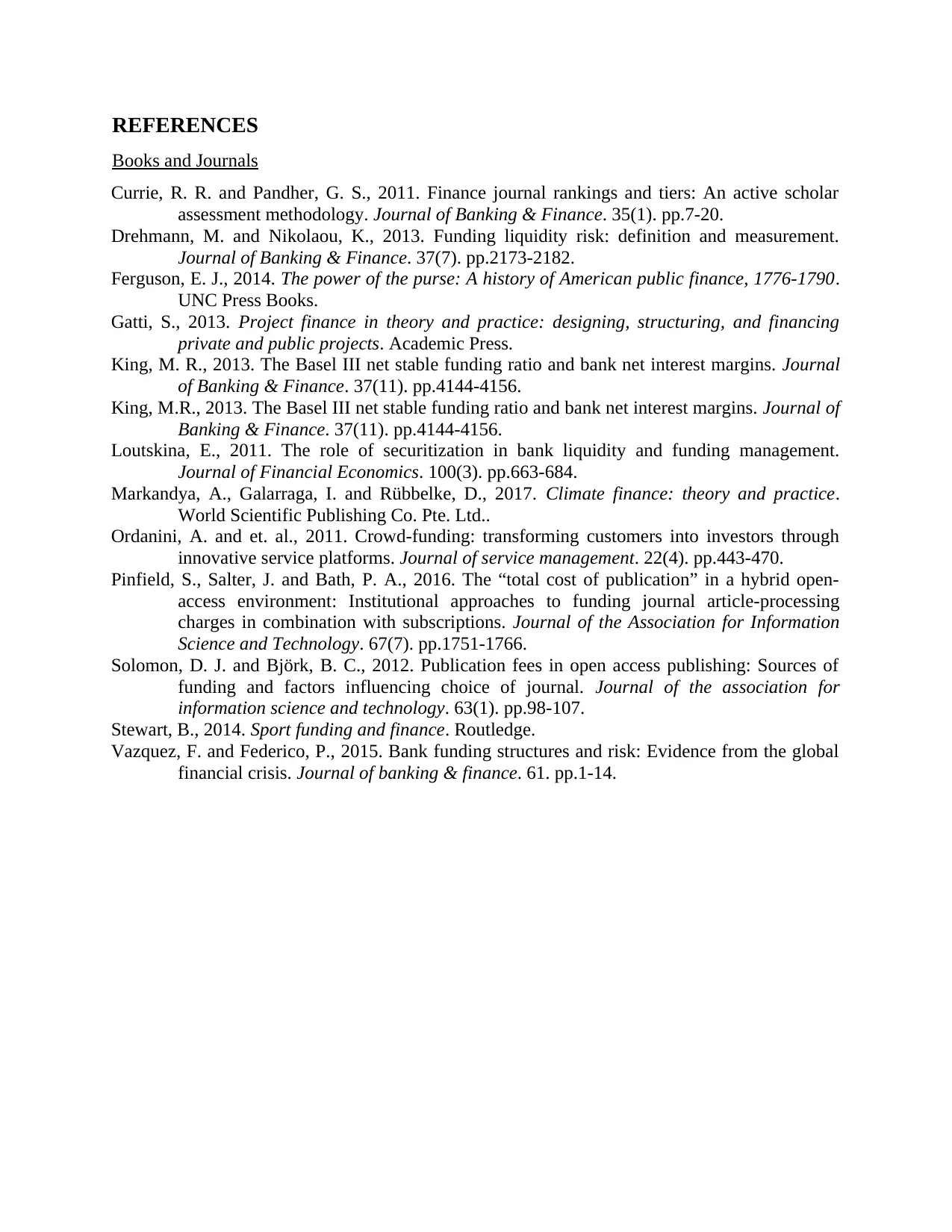
REFERENCES
Books and Journals
Currie, R. R. and Pandher, G. S., 2011. Finance journal rankings and tiers: An active scholar
assessment methodology. Journal of Banking & Finance. 35(1). pp.7-20.
Drehmann, M. and Nikolaou, K., 2013. Funding liquidity risk: definition and measurement.
Journal of Banking & Finance. 37(7). pp.2173-2182.
Ferguson, E. J., 2014. The power of the purse: A history of American public finance, 1776-1790.
UNC Press Books.
Gatti, S., 2013. Project finance in theory and practice: designing, structuring, and financing
private and public projects. Academic Press.
King, M. R., 2013. The Basel III net stable funding ratio and bank net interest margins. Journal
of Banking & Finance. 37(11). pp.4144-4156.
King, M.R., 2013. The Basel III net stable funding ratio and bank net interest margins. Journal of
Banking & Finance. 37(11). pp.4144-4156.
Loutskina, E., 2011. The role of securitization in bank liquidity and funding management.
Journal of Financial Economics. 100(3). pp.663-684.
Markandya, A., Galarraga, I. and Rübbelke, D., 2017. Climate finance: theory and practice.
World Scientific Publishing Co. Pte. Ltd..
Ordanini, A. and et. al., 2011. Crowd-funding: transforming customers into investors through
innovative service platforms. Journal of service management. 22(4). pp.443-470.
Pinfield, S., Salter, J. and Bath, P. A., 2016. The “total cost of publication” in a hybrid open‐
access environment: Institutional approaches to funding journal article‐processing
charges in combination with subscriptions. Journal of the Association for Information
Science and Technology. 67(7). pp.1751-1766.
Solomon, D. J. and Björk, B. C., 2012. Publication fees in open access publishing: Sources of
funding and factors influencing choice of journal. Journal of the association for
information science and technology. 63(1). pp.98-107.
Stewart, B., 2014. Sport funding and finance. Routledge.
Vazquez, F. and Federico, P., 2015. Bank funding structures and risk: Evidence from the global
financial crisis. Journal of banking & finance. 61. pp.1-14.
Books and Journals
Currie, R. R. and Pandher, G. S., 2011. Finance journal rankings and tiers: An active scholar
assessment methodology. Journal of Banking & Finance. 35(1). pp.7-20.
Drehmann, M. and Nikolaou, K., 2013. Funding liquidity risk: definition and measurement.
Journal of Banking & Finance. 37(7). pp.2173-2182.
Ferguson, E. J., 2014. The power of the purse: A history of American public finance, 1776-1790.
UNC Press Books.
Gatti, S., 2013. Project finance in theory and practice: designing, structuring, and financing
private and public projects. Academic Press.
King, M. R., 2013. The Basel III net stable funding ratio and bank net interest margins. Journal
of Banking & Finance. 37(11). pp.4144-4156.
King, M.R., 2013. The Basel III net stable funding ratio and bank net interest margins. Journal of
Banking & Finance. 37(11). pp.4144-4156.
Loutskina, E., 2011. The role of securitization in bank liquidity and funding management.
Journal of Financial Economics. 100(3). pp.663-684.
Markandya, A., Galarraga, I. and Rübbelke, D., 2017. Climate finance: theory and practice.
World Scientific Publishing Co. Pte. Ltd..
Ordanini, A. and et. al., 2011. Crowd-funding: transforming customers into investors through
innovative service platforms. Journal of service management. 22(4). pp.443-470.
Pinfield, S., Salter, J. and Bath, P. A., 2016. The “total cost of publication” in a hybrid open‐
access environment: Institutional approaches to funding journal article‐processing
charges in combination with subscriptions. Journal of the Association for Information
Science and Technology. 67(7). pp.1751-1766.
Solomon, D. J. and Björk, B. C., 2012. Publication fees in open access publishing: Sources of
funding and factors influencing choice of journal. Journal of the association for
information science and technology. 63(1). pp.98-107.
Stewart, B., 2014. Sport funding and finance. Routledge.
Vazquez, F. and Federico, P., 2015. Bank funding structures and risk: Evidence from the global
financial crisis. Journal of banking & finance. 61. pp.1-14.
1 out of 12
Related Documents
Your All-in-One AI-Powered Toolkit for Academic Success.
+13062052269
info@desklib.com
Available 24*7 on WhatsApp / Email
![[object Object]](/_next/static/media/star-bottom.7253800d.svg)
Unlock your academic potential
© 2024 | Zucol Services PVT LTD | All rights reserved.





